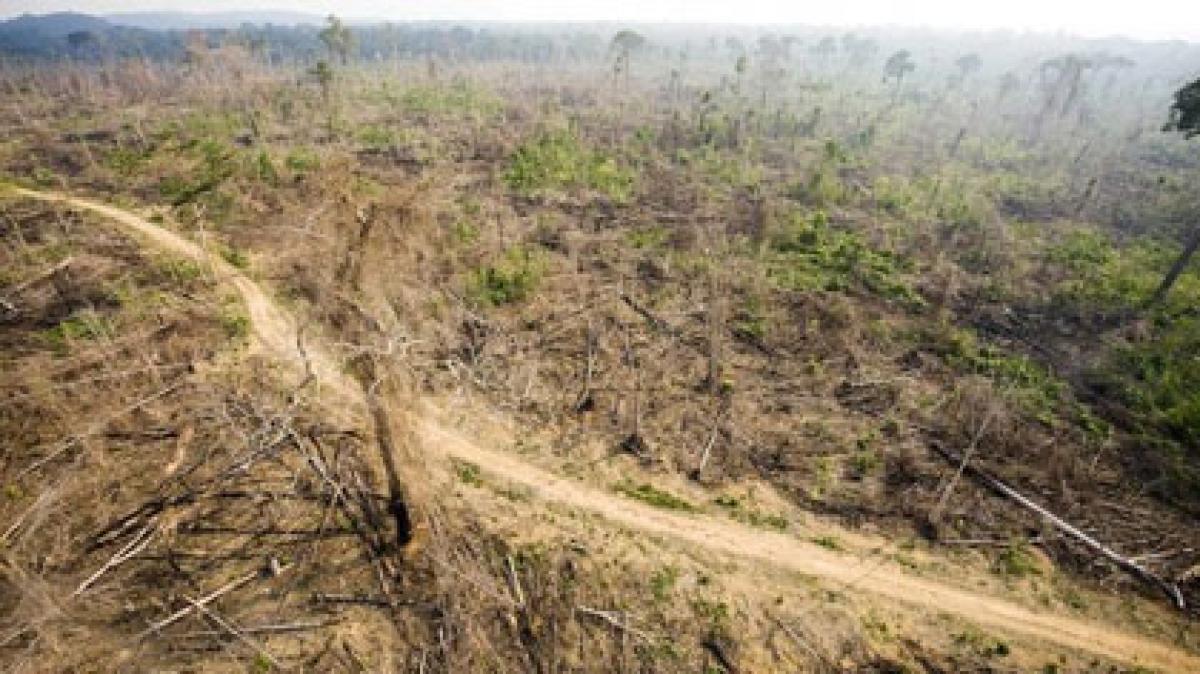Live
- Voter 'deletion' issue : Kejriwal-led AAP delegation meets EC
- KTR is daydreaming, flays Sridhar Babu
- Red roses given to BJP counterparts
- Dhankhar a govt spokesperson, biggest RS disruptor: Kharge
- Fire breaks out at petrol pump
- Facial recognition-based attendance in Sectt from today
- TGPSC to be restructured on par with UPSC
- Gabba pitch to have pace and bounce
- Not taking a break after Olympics left me emotionally drained
- SSC public exams from March 17 to 31
Just In

Telangana has only 16.74 per cent as forest cover i.e., 18,764.67 sq km. In terms of the forest canopy cover density classes, the State has 502.35 sq km of Very Dense Forest (VDF), 9,052.41 sq km of Moderately Dense Forest (MDF) and 9,209.91 sq km of Open Forest (OF).
 As per Telangana Forest Department’s ‘State of Forest Report 2014,’ 36.5 sq km of forest has disappeared from the State. The most negative change has been in Khammam circle where 14.45 sq km of forest has disappeared, followed by 6.15 sq km in Warangal. Encroachments were noticed in all 23 forest divisions and it was found that apart from the “lost forests,” 26.02 sq km of forests were encroached, of which 3.21 sq km area was in protected forest areas and 8.27 sq km under Vana Samrakshana Samities
As per Telangana Forest Department’s ‘State of Forest Report 2014,’ 36.5 sq km of forest has disappeared from the State. The most negative change has been in Khammam circle where 14.45 sq km of forest has disappeared, followed by 6.15 sq km in Warangal. Encroachments were noticed in all 23 forest divisions and it was found that apart from the “lost forests,” 26.02 sq km of forests were encroached, of which 3.21 sq km area was in protected forest areas and 8.27 sq km under Vana Samrakshana Samities
Telangana has only 16.74 per cent as forest cover i.e., 18,764.67 sq km. In terms of the forest canopy cover density classes, the State has 502.35 sq km of Very Dense Forest (VDF), 9,052.41 sq km of Moderately Dense Forest (MDF) and 9,209.91 sq km of Open Forest (OF). While the notified forest area in the State is almost 24 per cent, which comes to 26,903.70 sq km, this is different from the actual forest cover which considers only those areas which fall under VDF, MDF and OF.
As per Telangana Forest Department’s ‘State of Forest Report 2014,’ 36.5 sq km of forest has disappeared from the State. The most negative change has been in Khammam circle where 14.45 sq km of forest has disappeared, followed by 6.15 sq km in Warangal.
Encroachments were noticed in all 23 forest divisions and it was found that apart from the “lost forests,” 26.02 sq km of forests were encroached, of which 3.21 sq km area was in protected forest areas and 8.27 sq km under Vana Samrakshana Samities.
Maximum encroachment in protected areas was in the Kinnerasani Wildlife Sanctuary, at 2.69 sq km. The report also conveys a major failure of the Forest Department. While the department cleared 29.13 sq km of forest for raising and harvesting plantations for improvement of vegetation cover, the report clearly states that the growth of plantations was “not discernible.”
The forest department should stop clearing natural forest areas to raise plantations. This is having a more negative impact on forests than positive. Cattle grazing in forests, a major issue in Telangana, was found to be affecting a whopping 22,622.87 sq km of forests. High grazing was found to have occurred in 3,890.35 sq km, medium grazing in 8,216.52 sq km and low in 10,416 sq km.
The health of forests is also feeble in many areas. Severe soil erosion was found in 2,062 sq km, strong erosion in 11,554.15 sq km, moderate in 6,992 sq km and slight in 5,612.32 sq km. Besides this, there is an extensive loss of tree cover over the years in Adilabad. It has reduced the dependence of nearly 4 lakh-strong indigenous communities on the forest. The tribal district, considered to be the environmental haven of Telangana, needs its forests to regenerate to its original form to usher in development, experts say.
Until some decades ago, Adilabad had a forest cover of over 43 per cent of its geographical area of over 16,000 sq km. Unchecked felling of trees cost it dearly. According to the State of Forest Report 2013, there was a loss of nearly 1,900 sq km of a total of 7,230 sq km of notified forest cover.
The depletion of forests continues even now, as the report in question reveals that over 122 hectares of forest land had been encroached upon during 2012. The figure may be much higher given the manner in which the area of land under cultivation is increasing, with nearly 1.5 lakh hectares being added after the ratification of the Scheduled Tribes and Other Traditional Forest Dwellers (Recognition of Forest Rights) Act, 2006.
Traditional forest communities once eked out a living by depending on forest wealth. Following deforestation, their income has taken a serious hit. The New Forest Policy of 1988, which envisages the involvement of forest communities in the management of forest resources, appears to have failed, as ethnic people in the district are fast losing their knowledge about non-timber forest produce (NTFP). The initiative has not succeeded in ensuring the protection of forests, in the absence of which there cannot be any forest dependent commercial activity.
Many invaluable NTFP species of commercial value are on the verge of extinction. The process has to be reversed for forests to regenerate naturally by ensuring their protection and convincing the ethnic population that their environment can still yield sustenance. Natural regeneration requires avoiding clearance of forest and scrub lands to raise eucalyptus plantations.
By G Rajendera Kumar

© 2024 Hyderabad Media House Limited/The Hans India. All rights reserved. Powered by hocalwire.com







